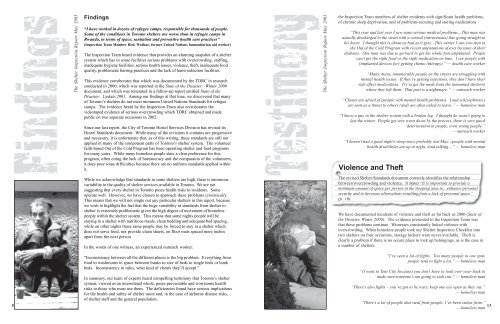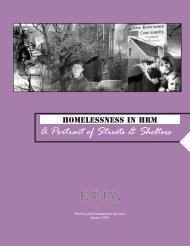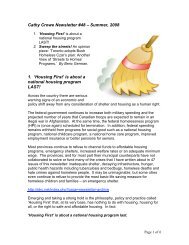Shelter Inspection Report - Toronto Disaster Relief Committee
Shelter Inspection Report - Toronto Disaster Relief Committee
Shelter Inspection Report - Toronto Disaster Relief Committee
Create successful ePaper yourself
Turn your PDF publications into a flip-book with our unique Google optimized e-Paper software.
Findings<br />
The <strong>Shelter</strong> <strong>Inspection</strong> <strong>Report</strong> May 2003<br />
Findings<br />
“I have worked in dozens of refugee camps, responsible for thousands of people.<br />
Some of the conditions in <strong>Toronto</strong> shelters are worse than in refugee camps in<br />
Rwanda, in terms of space, sanitation and preventive health care practices”<br />
(<strong>Inspection</strong> Team Member Rick Wallace, former United Nations humanitarian aid worker)<br />
The <strong>Inspection</strong> Team heard evidence that provides an alarming snapshot of a shelter<br />
system which has in some facilities serious problems with overcrowding, staffing,<br />
inadequate hygiene facilities, serious health issues, violence, theft, inadequate food<br />
quality, problematic barring practices and the lack of harm reduction facilities.<br />
This evidence corroborates that which was documented by the TDRC in research<br />
conducted in 2000, which was reported in the State of the <strong>Disaster</strong>: Winter 2000<br />
document, and which was reiterated in a follow-up report entitled State of the<br />
<strong>Disaster</strong>: Update 2001. Among our findings at that time, we discovered that many<br />
of <strong>Toronto</strong>’s shelters do not meet minimum United Nations Standards for refugee<br />
camps. The evidence heard by the <strong>Inspection</strong> Team also corroborates the<br />
videotaped evidence of serious overcrowding which TDRC obtained and made<br />
public on two separate occasions in 2002.<br />
Since our last report, the City of <strong>Toronto</strong> Hostel Services Division has revised its<br />
Hostel Standards document. While many of the revisions it contains are progressive<br />
and necessary, it is unfortunate that, as of this writing, these standards are still not<br />
applied in many of the component parts of <strong>Toronto</strong>’s shelter system. The volunteer<br />
faith-based Out of the Cold Program has been operating shelter and food programs<br />
for many years. While many homeless people state a clear preference for this<br />
program, often citing the lack of bureaucracy and the compassion of the volunteers,<br />
it does pose some difficulties because there are no uniform standards applied within<br />
it.<br />
Testimony<br />
The <strong>Shelter</strong> <strong>Inspection</strong> <strong>Report</strong> May 2003<br />
the <strong>Inspection</strong> Team members of shelter residents with significant health problems,<br />
of chronic sleep deprivation, and of problems securing and storing medications<br />
“This year and last year I saw some serious medical problems…This man was<br />
actually discharged to the street with a central (intravenous) line going straight to<br />
his heart. I thought this is about as bad as it gets…This winter I saw two men in<br />
the Out of the Cold Program with recent amputations of toes because of their<br />
diabetes. One man was due to go back to get his whole foot amputated. People<br />
can’t get the right food or the right medication on time. I see people with<br />
(implanted devices for) getting chemo (therapy).” — health care worker<br />
“Many, many, innumerable people on the streets are struggling with<br />
mental health issues. If they’re getting injections, they don’t have their<br />
side effect medications. Try to get the meds from the (unnamed shelters)<br />
where they left them. That part is a nightmare.” — outreach worker<br />
“Clients are afraid of (people with mental health problems). Loud schizophrenics<br />
are seen as a threat to others (and) are often asked to leave.” — homeless man<br />
“I know a guy in the shelter system with a broken leg. I thought he wasn’t going to<br />
last the winter. People get very worn down by the process, there is very quick<br />
deterioration in people, even young people.”<br />
— outreach worker<br />
“I haven’t had a good night’s sleep since probably last May…people with mental<br />
health disabilities are up at night, loud talking…” — homeless man<br />
Violence and Theft<br />
While we acknowledge that standards in some shelters are high, there is enormous<br />
variability in the quality of shelter services available in <strong>Toronto</strong>. We are not<br />
suggesting that every shelter in <strong>Toronto</strong> poses health risks to residents. Some<br />
operate well. However, we have chosen to approach these problems systemically.<br />
This means that we will not single out any particular shelters in this report, because<br />
we wish to highlight the fact that the huge variability in standards from shelter to<br />
shelter is extremely problematic given the high degree of movement of homeless<br />
people within the shelter system. This means that some nights people will be<br />
staying in a shelter with nutritious meals, clean bedding and adequate bed spacing,<br />
while on other nights those same people may be forced to stay in a shelter which<br />
does not serve food, nor provide clean sheets, on floor mats spaced mere inches<br />
apart from the next person.<br />
In the words of one witness, an experienced outreach worker:<br />
The revised <strong>Shelter</strong> Standards document correctly identifies the relationship<br />
between overcrowding and violence. It states “It is important to provide a<br />
minimum amount of space per person in the sleeping area to…enhance personal<br />
security and to decrease altercations resulting from a lack of personal space”<br />
(p. 16).<br />
We have documented incidents of violence and theft as far back as 2000 (State of<br />
the <strong>Disaster</strong>, Winter 2000). The evidence presented to the <strong>Inspection</strong> Team was<br />
that these problems continue. Witnesses consistently linked violence with<br />
overcrowding. When homeless people took our <strong>Shelter</strong> <strong>Inspection</strong> Checklist into<br />
two shelters on four occasions, storage lockers were never available. Theft is<br />
clearly a problem if there is no secure place to lock up belongings, as is the case in<br />
a number of shelters.<br />
8<br />
“Inconsistency between all the different places is the big problem. Everything from<br />
food to washrooms to space between bunks to size of beds to single beds or bunk<br />
beds. Inconsistency in rules, what kind of clients they’ll accept.”<br />
In summary, our team of experts heard compelling testimony that <strong>Toronto</strong>’s shelter<br />
system, viewed as an interrelated whole, poses preventable and worrisome health<br />
risks to those who must use them. The deficiencies found have serious implications<br />
for the health and safety of shelter users and, in the case of airborne disease risks,<br />
of shelter staff and the general population.<br />
“I’ve seen a lot of fights. Too many people in one spot,<br />
people tend to fight a lot.” — homeless man<br />
“(I went to Tent City because) you don’t have to look over your back to<br />
make sure someone’s not going to stab you.” — homeless man<br />
“There’s also fights – you’ve got to be wary, keep one eye open as they say.”<br />
— homeless man<br />
“There’s a lot of people that steal from people, I’ve been stolen from.”<br />
— homeless man<br />
13







